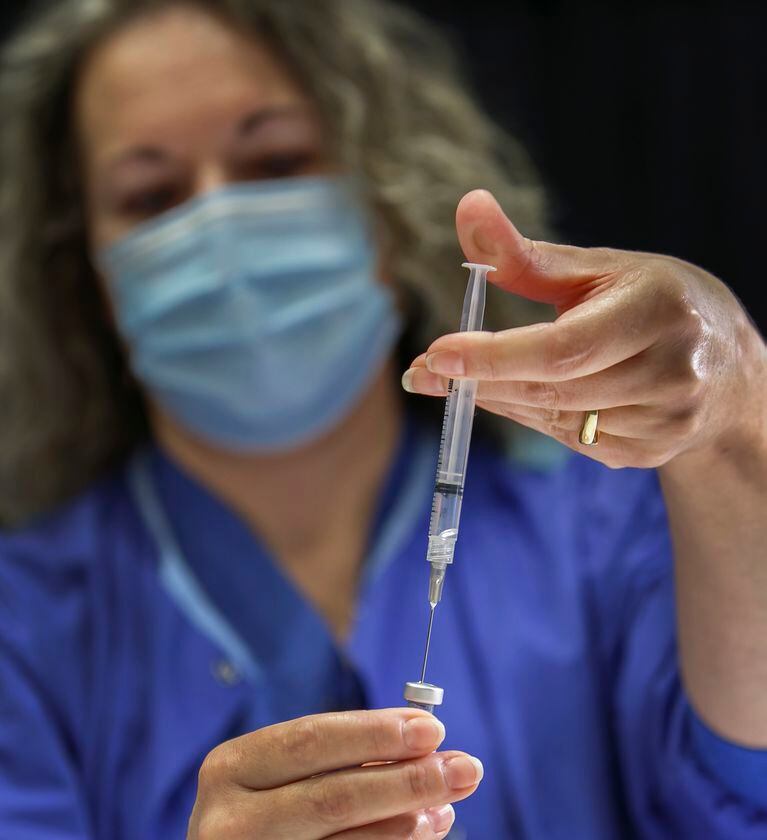What do we know about B.1.1.7?
B.1.1.7 first appeared undetected in Kent, in southeast Great Britain, and is the most common variant in the U.K.
Scientists are still learning more about this new variant. Early on, though, it became clear that the virus has a lot of mutations on its “spike” protein. The spike protein helps the virus enter cells, and gives the coronavirus such a, well, spiky surface.
The mutations in B.1.1.7′s spike proteins make it easier for the virus to enter cells. That seems to make it more contagious than previous versions of the COVID-19 virus. There’s also early evidence to suggest it could be more deadly.
Where did B.1.1.7 come from, and how did we find it?
In December, British Prime Minister Boris Johnson instituted new social distancing measures across the nation, in an attempt to keep cases low and reopen for Christmas. It looked like it worked everywhere, except in Kent.
Cases there kept rising, so researchers combed through a collection of viral genomes that had been uploaded to a national database to see if there was a reason. The U.K. had been collecting and sequencing the RNA of thousands of viruses from thousands of people with COVID-19.
Scientists identified the B.1.1.7 variant in early December, and the earliest known samples of this lineage had initially been collected in late September.
Related: 3rd Oregonian confirmed to have more contagious UK variant of COVID-19
By mid-December, this new variant had spread widely, and had become the variant causing the most infections in the U.K. and Ireland.
As cases began to skyrocket and hospitals rapidly filled up, the U.K. was forced to tighten social distancing measures. There was no COVID-safe Christmas, though Johnson did lift some restrictions for the holiday, despite the potentially dire consequences. The U.K. is currently in the third week of a third nationwide lockdown, which is expected to last until March.
What happened in other countries once the U.K. variant arrived?
When it arrives, it spreads quickly. In January, B.1.1.7 has accounted for 20% of the cases in Belgium, where it is now the most common variant found. Denmark is currently in a strict lockdown -- but the variant is still spreading. Scientists believe that despite the lockdown, the variant is increasing by 70% each week. Denmark sequences every COVID-19 sample, so its research is very robust.
So it’s more transmissible? What does that mean for us?
Our bodies are pretty good at killing viruses; we have a lot of defenses. While a virus is in our lungs or in our blood stream it’s at the mercy of an inhospitable environment, made even less hospitable by our immune systems. But once it enters a cell, it’s usually safe from our immune systems, and it can start to replicate. Eventually, we get sick.
Some viral mutations can make it easier for a virus to spread through the air, or survive outside of a human. So that can mean we’re more likely to get exposed.
It’s easier for B.1.1.7 to get into our cells. That means it’s more likely for an exposure to actually infect you. Scientists estimate the U.K. variant of the COVID-19 virus could be 70% more transmissible than the original variant, and may be 30% more lethal, according Patrick Valance, U.K. Prime Minister Boris Johnson’s chief scientific adviser.
So things that were relatively safe before might not be as safe any longer. But since we know that our risk of getting infected if we are exposed has increased, it’s a good idea to reduce our risk of getting exposed.
The variant B.1.1.7 might also be more deadly. How does that change things?
THANKS TO OUR SPONSOR:Become a Sponsor
If this variant does prove to be more deadly than others, plans designed to keep hospital intensive care units from being overrun will need to be adjusted. We currently assume that a certain percentage of diagnosed people will need to be hospitalized. A subset of that may require treatment in an ICU, or require oxygen and be placed on a ventilator. A more deadly virus changes all of that math.
How do we know if it’s here? How do we keep track of it?
Unlike some countries, the U.S. does not have any sort of nationwide COVID-19 genomics surveillance program. But when the virus first arrived in the U.S., a number of universities realized that they had the capacity to survey the virus’ genes, and already had a network set up to do so: the same network we use to track the flu.
In April, a small team of Oregon Health & Science University researchers opened a lab to sequence and survey COVID-19 as it spread.
“We had that expertise and saw an opportunity to become involved in trying to add genome surveillance on top of the existing testing that was happening,” said Ben Bimber, a virologist on the COVID-19 genomic surveillance team.
But it’s a secondary job for the people who work on the team — Bimber’s day job involves studying HIV and tuberculosis — so team members can only run a few hundred samples a week. And because OHSU is based in Portland, most of the samples they sequence come from Portland, too.

How prevalent is this variant in Oregon?
That is hard to say. So far, there’s only been a handful of B.1.1.7 cases identified in Oregon. Only one was identified by OHSU’s lab.
”But there’s obviously far more cases in Oregon and in general,” Bimber said. “Our data also generally lags at least a week, possibly more, behind. As we get more and more batches of data, we expect to see more cases.”
So far, OHSU has sequenced over 1,600 COVID-19 viral genomes. But OHSU’s head pathologist Dr. Donna Hansel said on “Think Out Loud” that OHSU has thousands of banked samples waiting to be processed, if they can find the lab capacity.
Think of it like the early days of the COVID-19 outbreak. Tests were so limited, they weren’t able to provide a good measure of how fast COVID-19 was spreading. The tests told us where people were getting tested, not where the virus was.
One crucial detail: All of the cases of the U.K. coronavirus variant found in Oregon so far shared no common connections.
“Typically, when you see something like this happening, we are assuming that there is broader spread in the community than we are actually detecting,” Hansel said.

How do we think B.1.1.7 will act here?
We are still in the early stages of research on this variant, but scientists using fairly simple models have been able to run through a few scenarios. Given how fast the variant spread in the U.K., one paper published in the Center for Disease Control and Prevention’s Morbidity and Mortality Weekly Report estimated that B.1.1.7 could be the dominant variant in the U.S. by the end of March.
Are there other variants? Where have they been found so far?
There are dozens of variants of COVID-19, but three have the caused most international concern: a strain from Brazil (called P.1), one in South Africa (B.1.351), and one associated with large outbreaks in California that originally came from Denmark (L452R.)
A number of others have been found in states and countries around the world. But they’re either not spreading fast enough to raise alarm bells yet, or — if they’re behaving differently than other variants — they’re spreading in places with less scientific surveillance.
As of Thursday, the U.K., Brazil, and South Africa variants have been found in the U.S. The first case of B.1.351, which is the South Africa variant, was found in South Carolina on Thursday, and the first case of P.1, the Brazil variant, was found in Minnesota on Monday.
On Friday, OHSU’s surveillance lab announced that it has identified cases of the Danish L452R variant in Oregon.
Do vaccines work against these new variants?
While we know a bit more about B.1.1.7, in part because of the U.K.’s robust viral surveillance program, there’s a lot of basic research that still needs to be conducted on these new lineages of COVID-19 as they emerge.
”We need to do more work characterizing these variants,” Bimber said. “Simply saying that a variant is spreading or dominant doesn’t tell you much about the properties of that virus. You have to measure the infectivity, look at its pathology, and look at whether it can evade antibodies.”
From the research done on B.1.1.7, it appears that antibodies from people vaccinated against COVID-19 work against the U.K. variant. That’s a strong piece of evidence that the vaccines can work, and so far it’s supported by data from outbreaks. Vaccine makers have felt safe enough to confidently say that vaccines are effective against this variant.
That may not be the case for other viruses, however. Early research shows that the South African variant, B.1.351, may be better at evading vaccine antibodies than B.1.1.7 and the original COVID-19 lineage. And preliminary data from Moderna shows that its vaccine produces six times fewer neutralizing antibodies for B.351 than the initial variant. Fortunately, the Moderna vaccine was incredibly effective to begin, so according to Moderna, the antibody response their vaccine creates is still enough to create immunity.
The Brazillian variant, P.1, appears to be very infectious. It is estimated that 75% of the people living in the Amazonian city of Manaus contracted the variant before it peaked there in May of 2020. Antibodies derived from COVID-19 patients are often used to treat severe forms of the disease. Those antibodies do not appear to be as effective against the virus circulating in Brazil. Though it’s not a study of antibodies produced by a vaccine, it suggests that vaccines may not be as effective against this variant, as well.
In a press conference Friday, Dr. Anthony Fauci, the U.S.’s top infectious disease expert, said the arrival of these new variants, particularly B.1.351 from South Africa, is a “wake up call.” The U.K., France and Germany have implemented new travel bans to prevent its spread.
